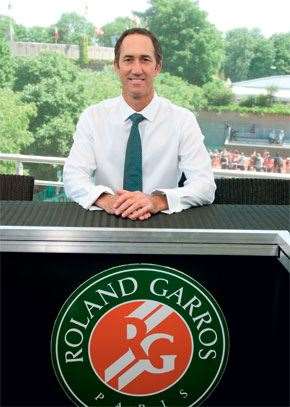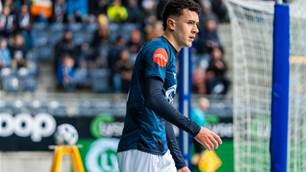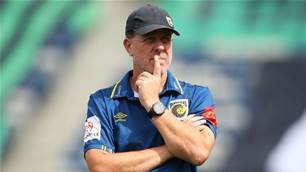During his career, he coached radically different number ones – Lleyton Hewitt, the youngest season-ending numero uno, and Andre Agassi, the oldest man to hold down the top spot.
 image by Getty Images
image by Getty ImagesDuring his career, he coached radically different number ones – Lleyton Hewitt, the youngest season-ending numero uno, and Andre Agassi, the oldest man to hold down the top spot.
Darren Cahill’s the man who said no to coaching Roger Federer; the tennis equivalent of passing on the Beatles. Few have succeeded across the game like the incisive, down-to-Earth and ultra-professional Cahill – aka Killer – who ranked as high as 22 in his playing days, and beat Boris Becker to reach the 1988 US Open semi-finals. When injury curtailed his career, he went on to coach radically different number ones – Lleyton Hewitt, the youngest season-ending numero uno, and Andre Agassi, the oldest man to hold down the top spot.
With the end of Agassi’s fabled career in late 2006, the South Australian joined US sports broadcaster ESPN as a rare on-camera Aussie, and quickly rose to elite-caller status, praised for his literacy – a word not liberally applied to the athlete-turned-commentator – as well as his “expert, thoughtful and almost invariably brilliant analysis”. And that’s coming from an American columnist. The Las Vegas-based Cahill, 45, knocked back both Federer and Andy Murray to stay in the ESPN booth and continue as consultant coach with Adidas, working with a variety of players in tandem with Agassi’s long-time, legendary trainer, Gil Reyes.
You said no to Roger Federer and yes to Adidas. It must be a heck of a gig ...
The Roger thing was a little more complicated than a simple no; Rog is a friend and we go a long way back. We never made it to the point of any job being offered, but I spent some time with him in Dubai (in March 2009) and thoroughly enjoyed it. Any full-time coaching job demands that you commit to a lot of weeks on the road and I just couldn’t get myself over that hurdle again. Roger was typical Rog, though, all class and very understanding. I was already very involved with the Adidas role and it came with a few upsides. It’s a great company offering a stable job, most of my coaching work is done in Las Vegas and, most importantly, I could continue working side by side with Gil Reyes.
You’ve been coach to two No.1s in Lleyton Hewitt and Andre Agassi. Is there a limit to the emotional energy a coach has to expend on No.1s?
The coaching job is the same no matter what level you do it at. You put your head down and work as hard as you can, ask a lot of questions and continue to learn. But the pressure at the top can certainly take its toll. You can put everything into the “learning process basket” when your player is on the way up. Learn from the losses and enjoy the wins, but everything is about the big picture. The problem with me starting with a 31-year-old Andre was that he was already the star of the big picture and there was no room for bad results. Andre quite often said that he never felt the balance was right for him in tennis. The wins never felt as good as he imagined them to be, and the losses hurt like hell. Far worse than he expected. Working with him was certainly a great challenge and a good coaching job will push you through any low moments.
Probably no other tennis champion has transformed themselves and their reputation more dramatically than Andre. How emotional was his last stand at the 2006 US Open?
Yeah, more than you can really explain in a few lines. Those final weeks were emotional for everyone involved, but he handled it in the manner we’ve come to expect, and that was to wear his heart on his sleeve and hold his head up high. His eyes have always been a dead giveaway. You could see how he was feeling the morning of his matches just by looking into his eyes. The eyes would project confidence, resolve, nervousness, fear and confusion, just to name a few. He could shoot us a look mid-match and we knew exactly what he was feeling, and probably the outcome of the match. That night against Baghdatis (Agassi’s last victory) he emptied the bucket of every emotion imaginable. The New York crowd is unmatched when it comes to creating a night to remember and those memories will be with us forever.
You’re still based in Las Vegas with your family and you still work with Andre’s surrogate father, Gil Reyes. Clearly your five years with Andre had a profound effect on you.
Our families are still very close. The boys, Benjamin and (Agassi’s son) Jaden, have been playing in the same baseball team, called Vegas Venom, for the last four years. The girls, Tahlia and (Agassi’s daughter) Jaz, hang out and play whenever possible. I’m still involved with Andre’s charitable foundation, and he and Stef (Agassi’s wife, Steffi Graf) jump on the court with the Adidas players whenever possible.
 image by Getty Images
image by Getty ImagesThe experience of working with Gilis not easy to explain. You have this guy who grew up in East LA, and pretty much had to fight for his life as a kid. He was stabbed and shot, and had to pump weights to get strong as a way to survive. He’s trained football and basketball teams, starred in movies alongside Chuck Norris and owned gyms in Texas where Arnold Schwarzenegger would train to win his Mr Universe titles. Then he took a complete left turn and went and trained a skinny, wild, long-haired tennis player called Andre Agassi, and did it for 15 years.He’s intimidating in every way possible, until he speaks. Gil has this deep, calming voice that holds your attention when he talks. He tells stories of the past and quotes famous athletes over and over. Not athletes that he’s read about, but world champions that he’s come into contact with and picked their minds to continue to learn. His training goes beyond getting athletes to become bigger, stronger and faster. It’s a given that he can do that. He’s a life coach. He makes people around him feel better about themselves and that’s a pretty unique quality to possess. Yeah, he’s become a good friend of mine and I feel fortunate to be able to say that. Plus, if I ever get myself into a fight, I have his number on speed dial!
In his book Andre mentions a bonding moment when you recommended a “baby whisperer” book that had your son sleeping “like a drunken sailor” …
He arrived in Sydney for the ATP year-end finals in 2001 and his son Jaden had just been born. He looked like he’d been dragged through the bush backwards and hadn’t slept in weeks. My wife swore by a book for newborns that encourages putting them on a sleeping/eating routine. She was like Hitler with this thing. When we arrived in the US to start working with Andre, he called Benjamin “the robot child” as he would pass out cold every night at 7.30pm, while Jaden was tearing up the house for another couple of hours ... until he finally ran out of steam and collapsed in a heap on the floor. I’m not sure that he ever read the book!
There’s endless intrigue in player-coach match-ups. Federer can’t seem to get comfortable with a coach. Nadal has the constant presence of his uncle Toni. Roddick and Murray seem to turn to a new coach when they need a mental/motivational lift. Sampras famously didn’t want a coach inside his head but to point out prosaic stuff like keeping the height on the ball-toss. Agassi had Brad Gilbert and yourself – in many ways diametric opposites to how he approached the game. What does the choice of coach reveal about the player?
That’s a good question. There’s no real easy way to answer that because everybody is so different, with so many different cultures and upbringings. Andre was one of the deepest thinkers in the game, but leaned on a coach heavily. Federer is also a deep thinker and great problem-solver, but leans on a coach far less in the day-to-day stuff. Most times, anyway, less is best. So, for a guy like Sampras, delivering a few key messages was much more important than babbling on just before a match. The Rafa relationship with his uncle Toni is a unique one. The player/coach relationship is flawed in tennis because it’s the player who signs the cheque, so there’s always a line a coach is reluctant to cross for fear of losing his job. The honest truth is not always delivered. Uncle Toni doesn’t get paid to coach Rafa, which is apparently his choice; he never wanted money to get in the way of their personal and professional relationship. It’s not only coaching ability that the player needs to consider when hiring, but also the personality of the coach. It’s a lot of time spent together at tournaments and on the road with dinners thrown in most nights. It’s probably why you’ve seen guys like Hewitt and Roddick lean more towards picking a coach from their home countries.
Both you and your father Jack (the ten-time premiership coach of Port Adelaide in the SANFL and former coach of Collingwood) have been elite coaches. Did you learn much about coaching from your dad? Have you studied coaches across other sports?
I learned to study tape, do my homework and never switch off. It drives me crazy sometimes because at times I would like to escape the game. In many ways, it’s tougher coaching a team sport as you are dealing with 40 different personalities, and charging through the front door to deliver a message is not going to work for everyone. The quality of the message and the way in which it’s delivered are crucial to the learning process for the athlete. Some players need to hear it a different way, so you need to find a side, back or even a trap-door to be effective. Jack was great at reading his players. He was also one of the first coaches of that era to study endless amounts of tape during the week.
What do you think of the WTA innovation of having coaches miked-up for courtside chats with their charges? Should that be more widespread? Is it compromising the integrity of the one-on-one contest for the sake of TV entertainment?
I love it. The opportunity to bring a different side of tennis into more living rooms is priceless. To know exactly what message the coach is delivering and how effectively the player is implementing that message is another reason not to change the channel. It’s not something the top men would ever like to see happen. They already problem-solve extremely well and would be giving up a little edge. However, we need to continue to evolve as a sport. The (Hawk-Eye) challenge system was not embraced by everyone, but it’s proven to be a huge success. We see it in most sports now where coaches or assistants are interviewed during competition. There’s more of that happening in tennis, but it needs to be more strongly enforced as part of the rules of the game.
You served as Davis Cup coach in 2007/08. Any interest in the captaincy further down the track?
Not after watching Fitzy in the job for the last decade! The poor bugger looks like he’s aged 30 years. He’s even got that reverse Mohawk thing going from all the stress. The Patty Rafter appointment by Tennis Australia was a beauty, though. It’ll be a great chance for Pat to become involved with some of the younger players and help them transition from juniors to seniors more effectively. Any ambitions the rest of us had of throwing our hats in the ring for the captain’s job should go on ice for a number of years. We’d all love to see Pat there for a long and successful stint.
In August this year, for the first time ever, no American man was ranked in the top ten. As someone who’s based in the US and works in sports broadcasting there, how did that go down?
Yeah, it was a big story. Anytime tennis is a lead story on ESPN’s Sportscenter, with baseball, football and basketball competing for airtime, you know everybody is sitting up and taking notice. I’m not sure if it says more about what the US has done wrong of late, or points more to the fact that the sport has become more global. My belief is the US and Australia have struggled to keep the really good athletes in the sport at a young age. The money, fame and lifestyle of the US sports are hard to ignore for any youngster. The same can be said for Australia, albeit to a lesser extent.
Is tennis in trouble without an American presence at the top?
The game isn’t in trouble, but interest in America would certainly suffer. It already suffered a fair bit with Agassi, Sampras, Chang and Courier disappearing from the game. There’s a couple of guys in Sam Querrey and John Isner who are good enough to break into the top ten. And don’t write off Andy Roddick just yet. He’s capable of pushing for another major title.
Talking sport to Americans isn’t exactly selling ice to the Eskimos, but close. How does an Aussie get a gig on ESPN?
I was probably in the right place at the right time, with Brad Gilbert taking the coaching job with Andy Murray, which left the ESPN team one man short. A good friend of mine, Andy Kay (from Channel 7) also sent me some commentary DVDs to send to ESPN and they gave me a trial at the Australian Open in 2007. I tried buying Andy a couple of beers as a thank-you, but he’s a red wine drinker, and only expensive stuff. I needed a bit of luck and thankfully it paid off, as it’s the job of a lifetime.
Do you have to lose or modify the Aussie-speak, or is the colourful Aussie vernacular part of the package?
I’m sure most people don’t know what in hell I’m saying half the time. I guess the accent is a plus, though. I stole a line from (former AFL star turned commentator) Billy Brownless one day; when one of my fellow American commentators was complaining on air, I referred to him as being a “sooky sooky la la”, thinking it would draw a few laughs. All I got was confused silence ...
Who in tennis will surprise us in 2011?
Grigor Dimitrov and Kei Nishikori are two names to watch out for next year. They’ve been tearing up the (second-tier) Challenger circuit. Grigor plays like a mirror image of Federer and is extremely entertaining to watch. He’s also coached by (former Aussie No.1) Peter McNamara who has made a big difference to his game in recent months. Juan Martin Del Potro is going to be a nightmare for all the top players, as his ranking has slipped and he won’t be seeded at most events. And keep your eyes on a young 14-year-old Aussie for a few years down the track; her name is Ashleigh Barty.
What are you looking forward to seeing on court this Australian summer?
John McEnroe and Ivan Lendl are heading to Adelaide for the World Tennis Challenge. It’s been a long time since those guys have faced each other and Ivan has been training the house down to get ready for it. Both guys still take a lot of pride in winning. Can Rafa make the “Rafa Slam” by winning four majors in a row? Will Sam Stosur break through for her first major on home soil? Maybe Murray will be the first Brit to win a major since Fred Perry in 1936? Is anyone good enough to beat Serena in Australia? Will Rusty (Hewitt) make another run? The list is endless. The Australian Open has come a long way in the last 20 years. Let the sun shine, the playersbe healthy and the competition be fierce. And maybe enjoy a couple of Coopers Pale Ales along the way ...
– Suzi Petkovski
Related Articles

Champion A-League coach set to join Premier League giants

Emerging Socceroos star set to sign for MLS club













